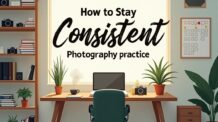Color is one of the most powerful elements in photography. It can set the mood, guide the viewer’s eye, create harmony or tension, and even influence emotional response. By understanding and applying color theory, you can elevate your images from visually pleasing to visually unforgettable.
In this article, you’ll learn the fundamentals of color theory and how to use it effectively in your photography — whether you’re shooting portraits, landscapes, products, or street scenes.
What Is Color Theory?
Color theory is the science and art of using colors together in a way that’s visually appealing and emotionally impactful. It includes:
- The color wheel
- Color relationships (complementary, analogous, triadic)
- Warm vs. cool colors
- Contrast and harmony
- Emotional effects of color
Photographers use these principles to compose more thoughtful and powerful images.
The Color Wheel Explained
The color wheel consists of 12 main hues:
- Primary colors: Red, blue, yellow
- Secondary colors: Green, orange, purple (made by mixing primary colors)
- Tertiary colors: Mixes of primary and secondary (like red-orange, blue-green)
Using combinations from the color wheel helps create intentional color palettes in your photos.
Common Color Harmony Schemes
1. Complementary Colors
Colors that sit opposite each other on the wheel (e.g., blue and orange, red and green, yellow and purple).
Effect: Bold, high contrast. Great for dramatic or energetic images.
Examples:
- A subject in an orange shirt against a blue wall
- Sunset light (orange) against a blue sky
2. Analogous Colors
Colors that sit next to each other on the wheel (e.g., red-orange-yellow or blue-green-purple).
Effect: Harmonious, calming, and cohesive.
Examples:
- A forest scene with various shades of green
- Street photography with matching cool tones
3. Triadic Colors
Three colors equally spaced on the wheel (e.g., red, yellow, blue).
Effect: Vibrant but balanced. Great for stylized shoots.
Examples:
- Colorful market scenes
- Product photography with coordinated props
4. Monochromatic
Different shades, tones, and tints of a single color.
Effect: Minimal, modern, emotionally focused.
Examples:
- A model dressed in all blue, with a blue background
- Desert scenes with layered tones of beige and brown
Warm vs. Cool Colors
- Warm colors (red, orange, yellow): evoke energy, warmth, joy, passion
- Cool colors (blue, green, purple): create calm, serenity, distance, sadness
Warm colors tend to pop and attract attention, while cool colors recede and feel more subtle. Use this contrast to highlight your subject or set a specific mood.
Color and Emotion
Color affects how we feel about an image:
- Red: energy, urgency, love, danger
- Blue: peace, isolation, trust, sadness
- Green: nature, growth, calm, balance
- Yellow: happiness, youth, caution
- Purple: mystery, luxury, creativity
- Black/white: contrast, timelessness, elegance, drama
When editing or planning a shoot, ask yourself: What do I want the viewer to feel? Then choose a color palette that reinforces that emotion.
Using Color in Composition
1. Make Your Subject Stand Out
Use color contrast to separate your subject from the background. A person in red against a green field will instantly catch attention due to the complementary contrast.
2. Create Flow
Use repeating colors throughout the frame to lead the eye and create visual rhythm.
3. Balance Strong Colors
A little red or orange can go a long way. Balance bold hues with neutral tones (white, gray, black) to avoid overwhelming the image.
4. Control with Clothing and Props
When shooting portraits or still life, you can plan your colors in advance — from wardrobe and makeup to props and background elements.
5. Use Color Grading in Editing
Adjust hues, saturation, and tones to enhance your photo’s mood and style. Lightroom and Photoshop offer tools like:
- HSL sliders
- Color grading panels
- Split toning
- Curves (for color channels)
Stay consistent with your color edits to create a recognizable style.
Practice Exercises
- Shoot a color-themed series: one dominant color per photo
- Recreate complementary color combinations using clothing and environment
- Capture a street scene using only cool or warm tones
- Convert a vibrant image to monochrome to study the emotional change
- Try editing one image in multiple color schemes to see the difference in mood
Final Thoughts
Color theory gives you the power to guide, engage, and move your audience — not just visually, but emotionally. It helps you compose more intentionally and edit more effectively, turning good photos into meaningful, memorable ones.
Don’t just chase color — learn to control it. Let color become one of your most powerful storytelling tools in photography.




Deixe um comentário